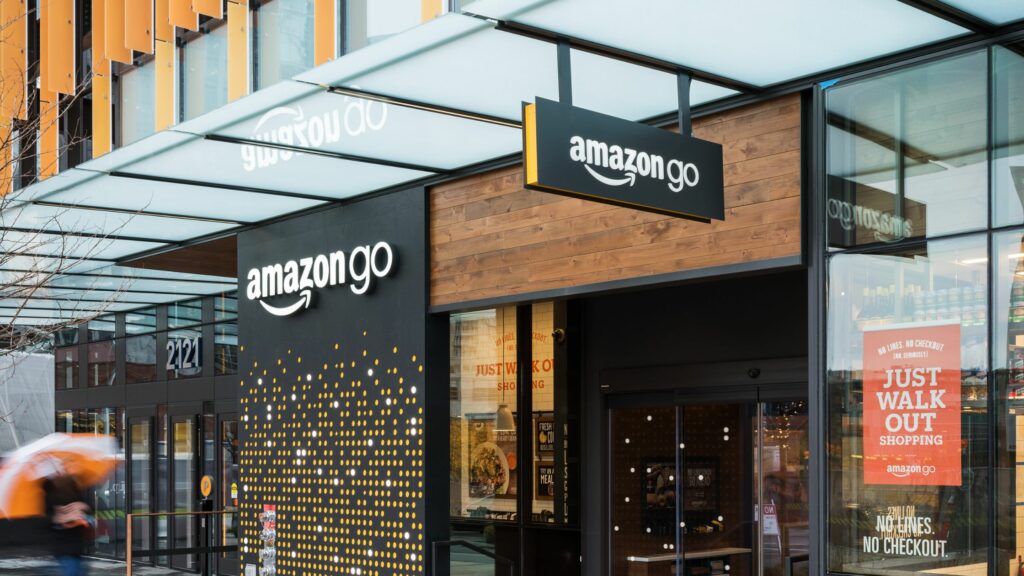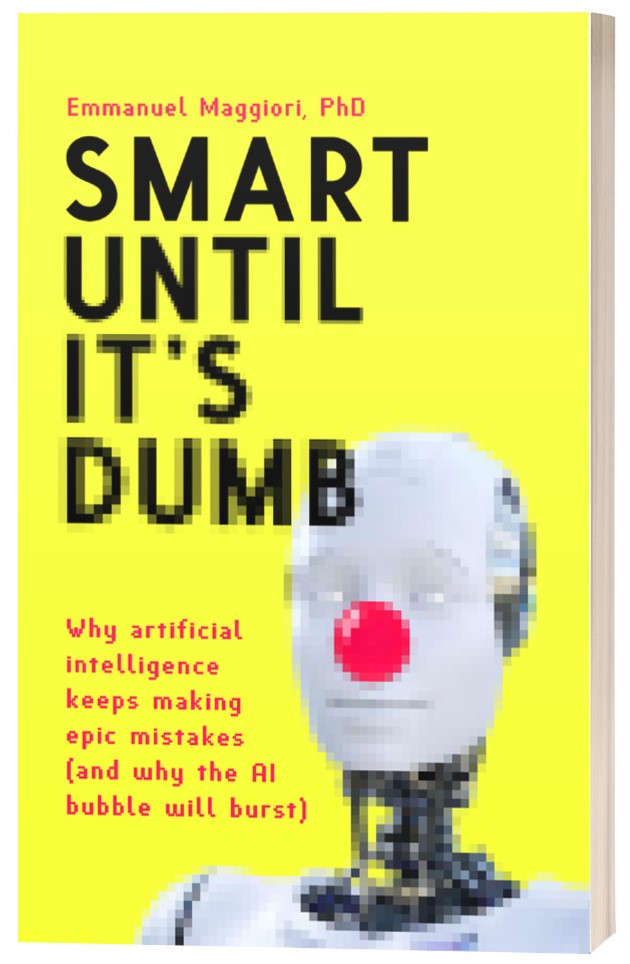A year ago, I walked into an Amazon Fresh store for the first time. We were about to have a picnic in a park, and one of my friends insisted on taking a detour to go to a nearby Amazon Fresh to buy our snacks; he was thrilled. He explained to me that the shopping experience was reminiscent of a Black Mirror episode, as you could grab the products from the shelves and just walk out—no checkout involved—and AI would magically know what you’d picked up and send you the receipt.
When I walked into the shop for the first time, it did indeed feel a bit like science fiction. You first pass your phone through a scanner at the turnstile to log in as an Amazon customer. You then pick up products while cameras over the ceiling film you; there are many of them and they seem to cover every inch of the store. The shopping experience is rather smooth, as there is no protocol to follow and no one tells you what to do—you can put products in a shopping bag, place them in a backpack, or carry them in your hands. Once you’re finished, you head to the exit and the gate opens automatically—no payment, no cashier, no app.
But then something sketchy happens: Almost immediately after walking out of the store, you receive a message from Amazon saying “thank you for your shopping” and explaining that they’re “preparing your receipt,” which you should receive soon. It usually takes a couple of hours until the itemized receipt is delivered to you and the payment is taken. The waiting time varies and can be as long as 50 hours according to some reports. If Amazon Fresh was truly powered by artificial intelligence, why the delay?
If you allow me the conjecture, I think I know what’s really going on.
What is really going on at Amazon Fresh?
Amazon’s cashierless technology, used both at Amazon Fresh and Amazon Go stores, was announced as a feat of artificial intelligence. In the technology’s promotional video the narrator says, “We used computer vision deep learning algorithms and sensor fusion much like you’d find in self-driving cars.” The video also says that your virtual cart would be updated “automatically” if you returned an unwanted product to the shelf.
I am sure Amazon Fresh effectively uses artificial intelligence to identify a customer when they leave the store to send the thank you message, as this happens immediately. The software needs to match the images of the person walking into the store with the footage of the same person walking out. This task, called person re-identification, is not easy but seems to be quite mature in today’s technology.
But I don’t think AI is truly used to identify the products picked up by customers as they navigate the store. I think Amazon struggled to produce effective technology for this, so they adopted a fake-it-till-you-make-it approach. I suspect that there’s a team of humans behind the scenes who manually inspect every video. Why else would it take so long for them to generate the receipt? And why would the time required for it vary so much, from a dozen minutes to over a day? A Bloomberg reporter pointed this out a while ago: “People familiar with the Just Walk Out technology say delays can be an indication that footage was flagged for human review to make sure the software correctly logged what was taken off the shelf. An Amazon spokesperson declined to explain the delay, and said shoppers across stores using Just Walk Out technology receive receipts within a few hours.”
In a Reddit discussion, an internaut said, “I bet it’s just a dark room with a bunch of dudes at a computer looking at the video feeds and confirming each cart purchase. Otherwise it should be instantaneous.” Another redditor added, “It looks like a smoke show because they have had these stores open for over 2 years now. That’s enough time to solve this issue (if it’s solvable).”
Maybe Amazon Fresh does use some AI to support the process. However, it appears to me that, if that’s the case, manual work is still required to validate each of AI’s outputs. Maybe the overall process is almost as time-consuming as just watching the videos without the help of AI. Who knows.
The fiasco of using manual work to generate outputs of alleged AI wouldn’t be new. Notably, the CEO of a start-up was charged with fraud in 2020 for pretending to develop AI software that could interpret video reviews posted by customers, when it appears that workers in India were being paid to watch the videos and register their impressions. And it seems that a large percentage of “AI startups” don’t even use AI in a substantial way.
The delay in sending receipts is not the only reason I suspect manual work is involved. I don’t think current AI methods, based on machine learning, are powerful enough to enable cashierless shopping, and thus a human is required in the loop. This is because current AI tends to perform poorly in out-of-the-ordinary situations, and cashierless shopping seems to be riddled with them. What if a person picked up a product and put it in a shopping bag but left the bag in the store? What if a user helped someone else reach for a product? What if you briefly held your friend’s shopping bag? My experience tells me that AI isn’t good at coping with out-of-the-ordinary scenarios, so one ends up having to add patch after patch to handle them, but it never ends.
We’ve seen this with self-driving cars, which keep blundering in embarrassing ways (like the car that got confused repeatedly by traffic cones). Manufacturers dismiss these mistakes by saying they’re just bugs that need to be fixed. However, new mistakes keep popping up every time the known ones are solved. Such is the situation that, as of today, no one has been able to produce a truly fully autonomous car and manufacturers seem to be giving up.
I think the Amazon folks were confident they’d soon fix all the problems that plagued their cashierless technology, so they overpromised. They’ve been trying to mend their system for years but they haven’t succeeded. Since no one has yet been able to find a way to overcome machine learning’s weaknesses, there is little hope they’ll attain their goal soon, and humans will have to continue to validate or even do AI’s work behind the scenes.
I predict that there will soon be an “AmazonGate”—a whistleblower will tell the world what truly is going on behind the scenes of Amazon Fresh. Maybe we already have an idea, as an article on The Verge has recently reported that teams in Costa Rica and India seem to be working night and day to manually review Amazon’s cashierless store videos.
Cart before horse, again
How has Amazon come to this? It seems rather unfortunate that a company would promise powerful AI technology and not deliver it for years. As I described in my book, this happens quite often. In fact, similar failed AI projects tend to follow a rather predictable path. It all starts when a company puts the cart before the horse—they decide to introduce some fancy technology without thinking about whether customers really want it and whether the technology will be up to the task.
I have long wondered in which way cashierless stores generate business value and address customers’ needs. Were they meant to be appealing to retailers because they reduced the number of employees required to run the shops? It doesn’t seem like it because cashierless shops still require employees to supervise the facilities and replenish shelves. Many traditional supermarkets now use self-checkout machines anyway, so they already run with almost no human cashiers.
Maybe Amazon expected that the futuristic shopping experience would be so enjoyable that clients would migrate to their shops. Avoiding queues, for example, would certainly be a good selling point. However, self-checkout machines have already reduced queues to virtually zero in many supermarkets, so I’m not sure time savings are all that great. Maybe Amazon expected that the lack of a checkout process by itself would be highly appealing to shoppers. I’ve done some polling and, while some people agree with that, others say they aren’t all that bothered by the ordinary checkout process and, if so, they can easily avoid it by ordering groceries online.
There might be value in cashierless stores. However, I get the impression that these stores were primarily launched as a futuristic experiment, much like the Metaverse. Their creators hoped people would change their habits to embrace new technology rather than having technology serve people’s existing needs. Maybe the signs of strain are already there. A few months ago, it appears that Amazon put the opening of new cashierless stores on hold “pending evaluation of the operation.” One of their London stores was closed as it didn’t succeed in changing neighbors’ habits, who still preferred other, cheaper supermarkets. And, in a few days, Amazon will be closing eight cashierless stores in Seattle, New York and San Francisco. It appears that futurism doesn’t pay the bills.


